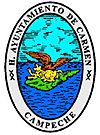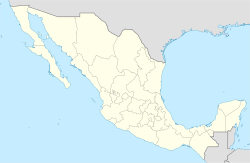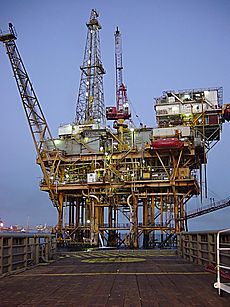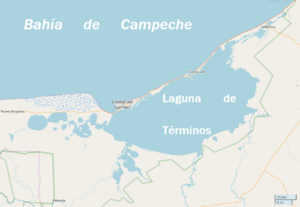Ciudad del Carmen facts for kids
Quick facts for kids
Ciudad del Carmen, Campeche
|
||
|---|---|---|
|
City
|
||

View of the city from the Laguna de Términos
|
||
|
||
| Nickname(s):
The Pearl of the Gulf
|
||
| Country | Mexico | |
| State | Campeche | |
| Municipality | Carmen | |
| City Founded | July 16, 1717 | |
| Area | ||
| • Total | 35.63 km2 (13.76 sq mi) | |
| Elevation | 2 m (6.6 ft) | |
| Population
(2020 census)
|
||
| • Total | 191,238 | |
| • Density | 5,367.3/km2 (13,901.3/sq mi) | |
| Demonym(s) | Carmelita | |
| Time zone | UTC−6 (Central (US Central)) | |
| • Summer (DST) | UTC−5 (Central) | |
| Area code(s) | 938 | |
| Major Airport | Ciudad del Carmen International Airport | |
| IATA Code | CME | |
| ICAO Code | MMCE | |
| Website | http://www.carmen.gob.mx/ | |
Ciudad del Carmen, often just called Carmen, is a lively city in the southwest of Campeche, a state in Mexico. It sits on the southwest side of Carmen Island, which is located in the Laguna de Términos on the Gulf of Mexico coast. In 2020, about 191,238 people lived there.
The city is known as "The Pearl of the Gulf" because of its beauty and importance. For a long time, Carmen was a small city focused on fishing. But in the 1970s, a lot of oil was found nearby. This discovery helped the city grow and develop a lot. Even today, Carmen is famous for its delicious seafood.
Before the 1980s, you could only reach the city by ferry boats. But then, bridges were built to connect Carmen Island to the mainland. The Zacatal Bridge, built in 1994, is one of the longest bridges in Latin America!
This area was once part of the state of Yucatán, and then Tabasco. But since 1863, it has been part of the state of Campeche. The city is also the main town of the Carmen municipality, which includes the city and the surrounding areas.
The main university in Ciudad del Carmen is the Universidad Autónoma del Carmen (UNACAR).
Contents
What's in a Name?
Why is it Called Ciudad del Carmen?
The city got its name on July 16, 1717. This was the day of the Virgen del Carmen, a special religious figure. On this day, pirates were defeated and kicked off the island by a leader named Alonso Felipe de Andrada. He fought them at the fort of San Felipe.
What Does the City's Shield Mean?
The Carmen shield is shaped like an oval. It has the city's name and state on its edge. In the middle, you see the Laguna de Términos and Carmen Island.
A lion on the island represents the times when European countries tried to control Mexico. An eagle, which stands for the people of Carmen, wounds the lion. This shows how the local people stopped foreign countries from taking over their land.
The original shield had a saying: "The lagoon by Yucatán and both by the Mexican Republic." This is because when the shield was created in 1828, Campeche was not yet a separate state from Yucatán.
A Look Back: Carmen's History
Early History of Carmen
Long ago, before the Spanish arrived, Ciudad del Carmen was known as Xicalango. It was an important port city and a link between the Aztec and Mayan civilizations.
Between the 16th and 18th centuries, the city became a hideout for pirates. They used it to fix their ships and plan attacks against Spanish ships. Maps from that time even showed Carmen Island as two islands, suggesting English pirates were active there, possibly cutting logwood for dye.
The city got its current name on July 16, 1717. This was after Spanish forces, led by Alonso Felipe de Andrade, finally drove the pirates away. Every year in late July, Ciudad del Carmen celebrates this victory with a big fair.
Colonization and Pirate Battles
When the Spanish first explored the area in 1518, Carmen Island was home to Maya people. The Spanish explorers, like Juan de Grijalva, thought the Laguna de Términos was the end of the land they had discovered.
However, the Spanish didn't settle the island right away. Instead, pirates started using it as a safe place to hide and plan attacks. They also cut dye stick wood to sell in Europe. Life for these pirates was very tough, working in hot, humid jungles full of insects and dangerous animals.
The Spanish tried many times to get rid of the pirates.
- In 1672, the first expedition from Veracruz failed.
- In 1680, a second attempt burned pirate camps, but they returned.
- In 1703, Captain Francisco Fernández managed to capture many pirates and destroy their supplies, but his forces left due to lack of money.
- In 1704, the Mayor of Tabasco, Alonso Felipe de Andrade, led an attack, capturing pirates and artillery.
- In 1707, another expedition succeeded temporarily, but pirates came back.
The Final Battle for Carmen
Finally, in 1716, the Mayor of Tabasco, Graniel de Gil, ordered a strong attack. On December 7, 1716, forces led by Sergeant Major Alonso Felipe de Andrade defeated the pirates again. This time, the winning forces stayed and built a fort called "San Felipe."
But the pirates didn't give up easily. On July 15, 1717, they attacked the fort by surprise. Sergeant Andrade and his men bravely fought back. Andrade famously told the pirates, "Men have enough gunpowder to not deliver the square!" He died in the battle, but his men kept fighting. By dawn on July 16, 1717, no pirates were left alive on the island.
This victory marked the end of pirate control. In 1786, more forces from Tabasco officially removed the English from the island for good. This ended nearly 200 years of pirate presence.
Carmen's Place in Mexico
For a long time, there was a disagreement between Tabasco and Yucatán over who owned Carmen Island. The island was moved between different states and territories several times.
In 1828, Carmen was given the title of "villa" (a small town). It also received its own shield. In 1841, it became an important port due to its busy sea trade.
During the war with the United States in 1846, Carmen was even occupied by US forces for a time. The people of Carmen asked the US forces to stay to protect them from local conflicts, like the Caste War in Yucatán.
In 1853, Carmen Island was declared a federal territory. But in 1856, it was decided that Carmen would return to Yucatán.
Becoming a City and a State
Because of its growing importance, the Mexican government officially made Carmen a "city" on July 10, 1856.
The political disagreements in the Yucatán Peninsula continued. Finally, on May 3, 1858, an agreement was signed to create a new state. This led to the official creation of the state of Campeche on April 29, 1863. Ciudad del Carmen became part of this new state.
French Intervention in Carmen
In 1862, France, England, and Spain sent their fleets to Mexico to demand debt payments. French forces arrived in Carmen in February 1862. Some people in Carmen supported the French, while others remained loyal to the Mexican Republic.
However, a yellow fever outbreak killed most of the French crew on their ship, "Le Granade." This helped the Mexican loyalists. In 1867, Mexican liberal forces finally took back Carmen.
After this, Carmen continued to grow. By 1871, it was exporting huge amounts of dye stick to Europe. The city was very busy, with many ships from different countries docking there. In 1874, a dye stick extract plant was built, and Carmen even got the first electric current generator for lighting in Mexico!
The Revolution and Beyond
During the Mexican Revolution, Carmen saw political changes. In 1910, Francisco I. Madero, a key figure in the revolution, visited Carmen during his campaign.
After the revolution, Carmen faced economic challenges. But in the mid-1940s, the city found a new economic boost: shrimp fishing. This industry became very important for Carmen's economy for the next 35 years.
Then, in March 1971, fisherman Rudesindo Cantarell discovered a huge amount of oil off the coast of Carmen. This changed the city's future forever. Since then, Carmen has become a major center for the oil industry, attracting many workers and companies.
Culture and Traditions
Stella Maris: The Star of the Sea
One of the most famous monuments in Ciudad del Carmen is the Stella Maris (meaning "Star of the Sea"). This huge Statue of the Virgin of Carmen is located in the waters of the Laguna de Términos, about 200 meters from the boardwalk.
The sculpture was finished in 2014 by Mexican artist Sergio Andrés Peraza Ávila. It weighs 12 tons and is 12 meters (about 40 feet) tall. The wave at the statue's base represents a storm, with the Virgin gently stepping on it to calm the waters.
Festivals and Fairs
The most important festival in Carmen is the July International Fair. It celebrates the city's founding and honors the Virgin of Carmen. It takes place every year from July 15 to 31. During this fair, there are religious events, fun rides, fishing tournaments, dances, and many vendors. A special part of the celebration is the sea procession of the Virgin of Carmen.
Another big tradition is the Carnival, which has been celebrated for over 200 years! It's a colorful and exciting party. In April, the Festival of the Sea features food shows, games, and sports.
The Guanal Fair, from August 1 to 15, honors Our Lady of the Assumption. The Guanal neighborhood used to have houses with palm-leaf roofs, which is where its name comes from.
Local Crafts
Since Ciudad del Carmen is on an island, many crafts are made from things found in the sea. You can find lamps, vases, and jewelry made from shells, snails, and fish scales. Artists also create miniature ships and figures of animals and pirates from coconut.
Wood carving is another popular craft. People make spice boxes, jewelry boxes, and other decorative items from wood. You can also find key chains, wallets, and bags made from shark skin. Some artisans even carve bull horn to create bracelets and other unique items.
Carmen on the Big Screen
Ciudad del Carmen has been a filming location for movies!
- In 1975, the Mexican film The braid was filmed here.
- In the 1970s, the French movie Rum Boulevard, starring Brigitte Bardot, was also shot on the island.
- More recently, in 2017, the film El Tormentero was made in Carmen. It tells the story of a shrimp fisherman who discovers a large oil well.
Exploring Carmen
Beaches to Enjoy
Ciudad del Carmen and Carmen Island have beautiful beaches. Some popular ones in the city area include Snail, Lace, Manigua, and North Beach.
Further east on the island, you can find other lovely beach areas like Bahamitas, Tortugueros, Port Royal, and Punta San Julián.
The Laguna de Términos
South of Ciudad del Carmen is the Laguna de Términos. The Spanish explorers named it "Términos" because they thought it was the end of the Yucatán island. This lagoon is the largest estuary system in Mexico. Many fish, crustaceans, shrimp, manatees, and dolphins live and reproduce in its waters. Its rich biological diversity is thanks to the rivers that flow into it.
The Laguna de Términos is part of a larger protected area for plants and animals. This area has huge mangrove forests, swamps, and jungles, which are home to many birds, reptiles, and mammals. It's one of Mexico's largest protected natural areas, covering over 705,000 hectares. Because of its unique nature, the Laguna de Términos was declared a Ramsar site in 2004, meaning it's an important wetland. In 2008, it was also added to a list of Mexican sites that could become a UNESCO World Heritage Site. This makes Ciudad del Carmen a great place for ecological tourism.
Historic Streets and Buildings
Ciudad del Carmen has old, narrow streets that tell stories of its past. For example, the old Calle del Comercio (now Street 22) was once a busy hub for trading dye stick, precious woods, and chewing gum.
Other important places include:
- Marian Diocesan Sanctuary of Our Lady of Carmen and Zaragoza Park: This is the heart of the city. The church, built in 1856, has beautiful architecture. Zaragoza Park, with its lush plants, is next to the church. Here you'll find the City Theater, the University Cultural Center, and a fountain called "Monument to the History of the Laguna de Términos." The traditional kiosk in the park is a symbol of the city.
- Victorian Snow Museum: Located in an old hospital, this museum takes you through Carmen's history. You can see ancient Mayan pottery, learn about the early days of Tris Island, the expulsion of pirates, and the city's role in the dye stick trade. It covers everything from pre-Hispanic times to modern Mexico.
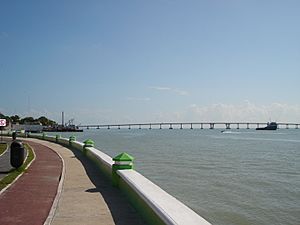
- El Zacatal Bridge and Malecon: The El Zacatal bridge is the longest bridge of its kind in Latin America, stretching 3,861 meters (about 2.4 miles). It's a main entrance to the Yucatán Peninsula.
Every evening at 8:00 p.m. and 9:00 p.m., there's a light and sound show at the bridge and boardwalk. It highlights the bridge's greatness and shows videos about the island's history and Campeche tourism. If you're lucky, you might even spot dolphins from the bridge or boardwalk at sunset!
Sports in Carmen
Ciudad del Carmen has many sports facilities:
- The Resurgence Stadium: Opened in 1967, this baseball stadium can hold 8,200 people. It was home to the "Camaroneros del Carmen" and "Delfines del Carmen" baseball teams.
- The "Delfín" Stadium: This professional football (soccer) stadium has space for 15,100 people. It was home to the "Delfines Fútbol Club." Both the Resurgence and Delfín stadiums are owned by the UNACAR.
- "Nelson Barrera Romellón" Baseball Stadium: Named after a famous Carmelite baseball player, this stadium is used by the "Camaroneros del Carmen" and also hosts cultural and religious events.
- "Mundo Maya" Sports Unit: Opened in 2017, this large complex has fields for soccer, beach volleyball, basketball, baseball, and tennis. It also has a semi-Olympic pool and a gym.
- The "Revolution" Court: This indoor court hosts basketball games, boxing, wrestling, and martial arts.
- "November 20" Sports Unit: One of the oldest sports areas, it has a softball/baseball field, two gyms, and courts for various sports like volleyball, boxing, and judo.
- Children's Sports Unit: This unit hosts children's league games for football, soccer, baseball, volleyball, basketball, athletics, and rugby.
Getting Around Carmen
Ciudad del Carmen is well-connected by land, sea, and air.
- Bridges: The Unity Bridge connects Carmen Island to Isla Aguada in the east. The Zacatal Bridge links the island to the Atasta Peninsula in the south.
- Port: The Puerto Isla del Carmen provides sea access.
- Airport: The Ciudad del Carmen International Airport serves the city. There's also a large helipad at the airport, which is one of the busiest in the world for helicopter flights, mainly serving the oil industry.
Main avenues in the city include Avenida 10 de Julio, Avenida Isla de Tris (connecting the two parts of the city), and Juarez and North Peripheral Avenues.
Puerto Isla del Carmen
Carmen has always been an important natural port for trade. In the past, the city's economy revolved around its docks and shipyards.
Later, with the shrimp boom, the Laguna Azul Fishing Port was built. Today, the Puerto Isla del Carmen is one of the busiest ports in Mexico for ship movements. It's a key support center for the oil industry, moving people, food, and materials to the oil platforms in the Campeche Bank. The port is currently being modernized and expanded.
Ciudad del Carmen International Airport
The Ciudad del Carmen International Airport is located east of the city, close to shopping areas and hotels. It's very important for the city's economy.
The airport has a large platform for commercial planes, three parking spots, and a runway 2.2 kilometers (about 1.4 miles) long. It also offers car rentals and public transport.
Many companies that work for Petróleos Mexicanos (Pemex), Mexico's national oil company, operate helicopters from the airport's helipad. This helipad has more flight hours than any other in Mexico and is one of the busiest globally.
The airport is growing, with plans to expand its terminal building and parking. Large shopping centers, like Zentralia Square, have also been built on airport land, boosting the city's economy.
Carmen's Economy
Ciudad del Carmen has always been important for Campeche and Mexico because of its location and natural resources. First, it thrived on dye stick and chewing gum. Then came shrimp fishing. Now, its economy is driven by oil.
Oil is extracted from the Sonda de Campeche (Campeche Sound), and Ciudad del Carmen is the main base for these operations. This means many services are needed in Carmen to support the oil exploration and production activities of Petróleos Mexicanos.
City Government
Ciudad del Carmen is the main city and administrative center of the Carmen municipality.
Geography of Carmen
Ciudad del Carmen is located on Carmen Island, which covers about 11,513 hectares (about 44 square miles). The island is about 40 kilometers (25 miles) long and 6 to 8 kilometers (3.7 to 5 miles) wide at its widest points. Most of the island is only 2 to 3 meters (6.6 to 9.8 feet) above sea level.
Carmen's Climate
Like most cities along the Yucatán's Gulf Coast, Ciudad del Carmen has a Tropical savanna climate. This means it has a clear dry season from January to May. The wet season lasts for the rest of the year. September and October are the rainiest months, with a lot of rainfall.
| Climate data for Ciudad del Carmen, Campeche | |||||||||||||
|---|---|---|---|---|---|---|---|---|---|---|---|---|---|
| Month | Jan | Feb | Mar | Apr | May | Jun | Jul | Aug | Sep | Oct | Nov | Dec | Year |
| Mean daily maximum °C (°F) | 28 (82) |
29 (84) |
32 (90) |
34 (93) |
35 (95) |
34 (93) |
34 (93) |
34 (93) |
33 (91) |
31 (88) |
29 (84) |
28 (82) |
32 (90) |
| Mean daily minimum °C (°F) | 20 (68) |
21 (70) |
22 (72) |
24 (75) |
25 (77) |
25 (77) |
25 (77) |
25 (77) |
24 (75) |
24 (75) |
22 (72) |
21 (70) |
23 (73) |
| Average rainfall mm (inches) | 38 (1.5) |
26.3 (1.04) |
35 (1.4) |
51.8 (2.04) |
52.5 (2.07) |
132 (5.2) |
113.2 (4.46) |
124.5 (4.90) |
235.3 (9.26) |
284.3 (11.19) |
178.5 (7.03) |
139.2 (5.48) |
1,410.6 (55.54) |
| Source: World Weather Online | |||||||||||||
People of Carmen
Many people living in Ciudad del Carmen have moved there from other places. This mix of people from different backgrounds creates a diverse and interesting culture. The oil industry is a big reason for this movement, bringing people from all over to work and live in Carmen.
Images for kids
Sister Cities
International
See also
 In Spanish: Ciudad del Carmen para niños
In Spanish: Ciudad del Carmen para niños


